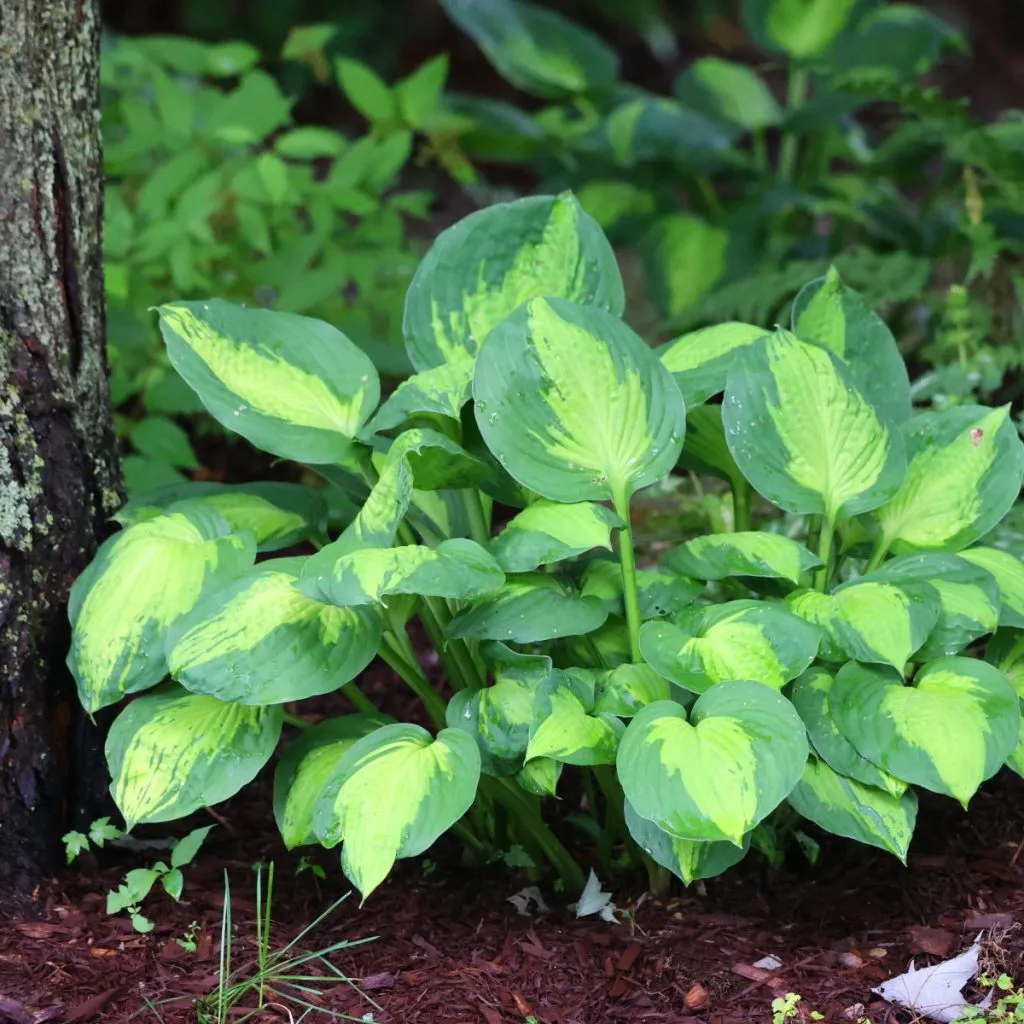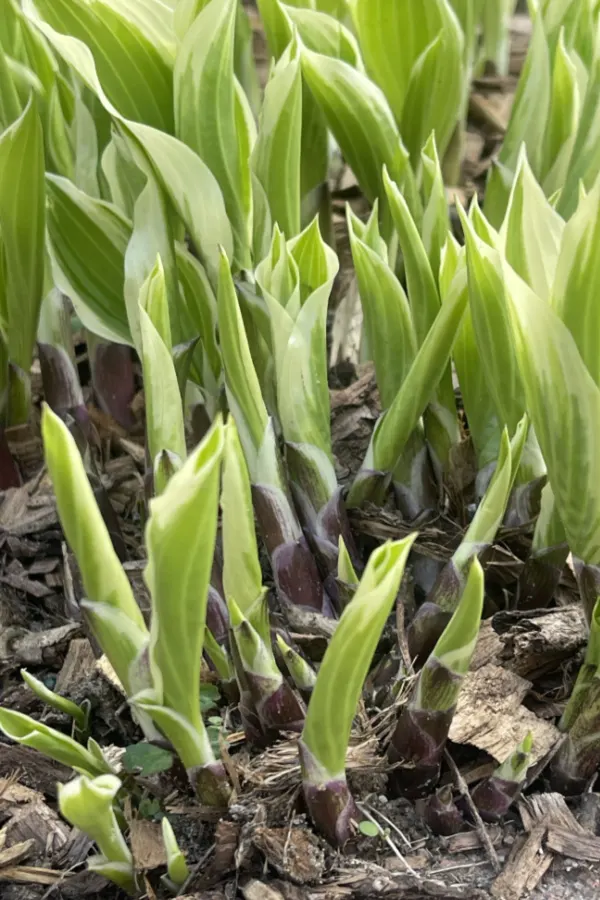Now is the time for a little spring hosta care!
As winter fades away and the garden starts to wake up, spring makes for the perfect time to care for one of the most beloved shade-loving plants of all – hostas. The hardy perennial is a true workhorse in home flowerbeds, especially when they are healthy and vibrant.
One thing is for sure, with a little attention in early spring, hostas can grow to be gorgeous. But if you want them to really shine, there are three simple but important tasks you should do as soon as the weather starts to warm. The good news is that all three are easy to do!

Spring Hosta Care – 3 Great Ways To Help Hostas Grow Better!
#1 Clearing Away Old Foliage
The first thing to do when caring for hostas in spring is to clean up any old, dead foliage still hanging around from the previous year. While it might seem harmless to leave the old leaves in place, they can actually create a lot of problems.
As hostas go dormant in late fall, their leaves die back and collapse onto the soil. These leaves become soggy and decayed over winter, especially in wet or snowy climates. If you don’t remove them in early spring, they make it harder for new shoots to break through the soil.
Even worse, decaying leaves can hold in moisture that leads to rot or mold. And they also provide a hiding spot for pests like slugs, which love to munch on tender new hosta leaves as soon as they appear.
To give your hostas a fresh start, gently rake away or pull off the old foliage from around the plant crowns. If you won’t be dividing, be careful not to damage the small, pointed shoots that are just starting to push up through the soil.

Removing the old foliage helps prevent rot and pests. But even more, it also allows sunlight and air to reach the new shoots. That helps the plant warm up faster and grow stronger. Once the area is cleaned out, you can also add a light layer of mulch around the plants. This helps hold in moisture and keep weeds away. Just make sure not to pile mulch directly over the crown.
#2 Dividing Overgrown Hostas In The Spring
Hostas are long-lived perennials that tend to grow bigger and fuller each year. While that might sound like a good thing, they can eventually become too crowded if left alone for too long.
When hostas become overcrowded, the center of the plant often starts to thin out or even die, while the outer edges keep growing. You might notice that the plant blooms less, or that the leaves aren’t as large and vibrant as they used to be. That’s a sign it’s time to divide.
Most hostas benefit from being split up every three to five years. And spring is one of the best times to do it, right as the plant is just beginning to wake up. Dividing your hostas not only helps keep the plant healthy and strong, but it also gives you free new plants to fill out your beds or share with friends.

How To Divide Hostas In The Spring
To divide a hosta, start by digging up the entire plant clump. Try to dig around and under the root ball so you can lift it up in one piece. Once it’s out of the ground, use a sharp spade, knife, or garden saw to split the clump into smaller sections.
Each division should have a good set of roots and at least two or three growing pips or buds. Don’t worry too much about being exact. Hostas are very forgiving and bounce back quickly after being divided.
If the center of the clump is dead or soft, go ahead and toss it. As hostas age, they will die off from the center outward. If this is the case, just replant the healthy outer sections. Once you’ve split the plant, replant each division at the same depth it was growing before, and water them in well.
Dividing helps open up space so the roots can grow more freely. It also keeps air flowing around the plant and prevents mold or mildew from developing. If you divide in early spring, the plant will have the entire growing season to settle back in and develop strong new roots.
#3 Feeding Hostas – The Final Step Of Spring Hosta Care
The third step in spring hosta care is to give your plants a bit of early-season nutrition. While hostas are fairly low-maintenance and don’t require a lot of fertilizing, a dose of the right fertilizer in early spring can help them grow bigger, stronger leaves – and have more vibrant blooms.

A balanced granular fertilizer with equal parts nitrogen, phosphorus, and potassium is ideal. Because hostas are mainly grown for their foliage, giving them a balanced feed early on helps them develop full, lush leaves from the start. Affiliate Link: The Andersons PGF Balanced 10-10-10 Fertilizer.
How To Fertilize
To fertilize, apply the granular fertilizer directly to the soil around each plant. Be careful not to let it sit on top of the leaves or crowns. Once applied, water the area well to help the fertilizer soak into the soil and start working its way to the roots.
If you’ve just divided your hostas, wait about two weeks after replanting before applying fertilizer. This gives the roots time to adjust and settle in. After that, a single application in spring is usually enough to carry the plant through most of the season.
You can also give your hostas a second light feeding in mid-summer, especially if they are in containers or pots that lose their nutrients quickly.
Caring for hostas in the spring doesn’t take a lot of time, but it does make a big difference! By taking time now to clear away last year’s dead leaves, splitting up any plants that have gotten too crowded, and giving each plant a little spring fertilizer, you give them exactly what they need to thrive all season long.
Once mid summer rolls around, if your hostas need a little TLC, see: The Secret To Keeping Hostas Lush, Green & Beautiful In The Summer. And don’t forget to clear those plants out this fall to set the stage for next spring! See our article: What To Do With Hostas In The Fall.
Simple Garden Life
Follow Our Facebook Page For Even More Great Tips! Simple Garden Life Facebook Page
Simple Garden Life is a website dedicated to keeping gardening fun, simple and enjoyable! We publish two new articles each week along with a new garden podcast episode every two weeks. This article may contain affiliate links.
Spring is the time when hostas are just starting to grow, and these three simple tasks help them get off to a strong start. Whether your hostas are a few years old or you’re just planting new ones this season, a little attention now will help them flourish with thick foliage and strong growth all the way through fall.
